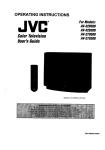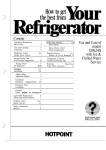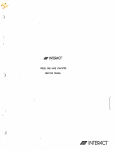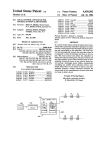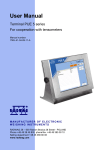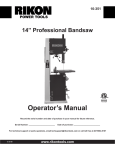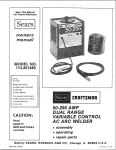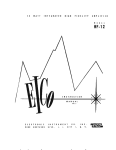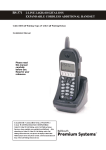Download Eico HF 12 Instruction manual
Transcript
14
WATT
HIGH
FIDELITY
POWER
AMPLIFIER
MOD E L
HF·14
A
INSTRUCTiON
MANUAL
E L E C TRDNIC
330 D
NORTHERN
INSTRUMENT
CO.
BLVD.,
l. J.
BITT
Iffw-•• £,,1',
OT
'/UI"nl'A'
-A
.>'Y.
W. f!A,,;,t "II(
:7""
:F. ~.> W•.
~~..
...+-
INC •
".
1.
general description
chClJ"Qctertsti~ under speaker load (Including electrostatic
types) as well as the resistive load normally used for testIng. Phase eerreetlens have been provided at both extremes of the audio spectrum to insure stability under all
conceivable eendltlens and to insure that variations in
components and constnJctlon wi II not affect the performance. Stability is maintained on all speaker taps with
loads rongingfrom zero to infinity. Overload characteristics are excellent and the HF-14will notexhlbit bounce
or flutter under pulsed conditions.
GENERAL
The EICO HF-14 Is a 14 watt high fidelity basic power
amplifier employing two EL84 output tubes In push-pull
and a high quality output transformer. The high power
sensitivity of these remarkably fine tubes eliminates the
necessity for additional driver stages, permitting the use
of a large cmountofinversefeedbackwlth Q highstabiHty
margin. The lower operating voltages required and the
use of EZS1 rectifier tube having (I warm-up characteristic exoctlymotched to the output tubes, result in a power
supply of exceptional reliabilityas well as extended output tube life. Filter electrolytlc.s and the rectifier operate well below mQKlmum ratings and voltage surges at
starting are eliminated.
The HF-14can be operated from any premlpllfier control
unit. A power take-off socket is provided for powering
the EICO HF-65A.orHF-61Apreanplifier control. Other
features include a panel mount fuse holder, switched and
unswitched convenience outiets, and heavy gauge cadmium plated steel chassis finished in baked enamel.
The HF-l4 has been designed to maintain Its excellent
SPECIFICATIONS
.
Rated Output Power: 14 watts continuous, 28 watts peak.
1M Distortion (60cps & 7kc at 4: 1): 1.7% at 14 watts, 0.33% at 26 watts, 0.1% at 4 watts.
Harmonic Distortion:
8 watts less than 1% from 30c to 10kc.
10 watts: less than 1% from 40c to 10kc.
14 watts: less thCl"l 1% from SOc to 5kc.
20c distortion: 2% at 4.2 watts.
Transient Response: excellent square WeNe reproduction (4usec rise time); negligible ringing, rapid settling on IOkc
square wave.
Invene Feedback: 20db
Tubes: 1- ECc83/12AX7, 2- ELM, 1- USI
Stability Margin: 12db
Power Source: 117 volts, 60 cps.
Damping Factor: above 8, 20cps to 2Okc.
Power Consumption: 65 watts
Sensitivity: 1.2S volts for 12 watts output.
~ HWD: 33/411 x 12" x 4".
Hum: 90db below rated output
Shipping Weight: 101bs.
Speaker Connections: 4, S, and 16 ohms.
\
mechanical In.hlilation
GENERAL
0) HEAT DISSIPATION (VENTILATION), Ineemecnwlth
,9ther electronic equipment; the Model HF-14prbduees a
gr8c;rt deal ofhed I" normal operation. Unle.. conttn~
uous and adequate air- flow I, obtained around the heat
pr'Oducfngelements,these. elementswill overheat and their
usefulllfewlUbegreatlycurtalled. Adequateventllation
will be provided I' the ampllfler·I, JrlItOlledln CIl openbackconsoleprovlded,that the topaf the ~ltfJer Ii spaced at lealt two Inchel'belbw any ,h.lf mounted aboVe it.
if the cabinet is enci~ed at the rear, provide several large
hoI.. or slots eli low clown and as 'high'up In the cabinet
back CIS poalble. AI ~ altemate, hoi. may be provided
In the sid., bottom,or top of the cabinet. Thelmportant
thing to remember Is that effective ventJlatlon requires
provision for cool oir to eriter at the bottom and to leave
at the top.
.
._.
If the ampUfier Is not Installed In a console, It should be
situated preferably on. an open surface. An attractively
ftni.hed matchIng cover forthe Mod.1 HF...14 is available
which will provide a "flnllhed lt appearance as well CIt
protection when the amplifier itnotlnstalled In a console.
Four rubber feet are also provIded 10 that the amplifier
will not mar the suri'ace of fumiture on which it is placed.
b) ACCESSIBILITY TO PARTS: Tubes are tho
moot fre-
quently replaced Items In electronic equipment. If the
amplifier II placed in a console, sufficient space should
be allotted to reach and remove ony tube In the amplifier. Furthermore, Input and output terminals of the amplifier should be accessibl. to permit e<lSy interchanging
of system components far comparison. If antennas are
strung around the back of the console In which the amplifier is Installed, arrange them so they will not interfere.
c) ELECTRICAL ISOLATION: To realize thefull benefit
of having a power ampllfl.r physically separate from the
preampllfJer'"'COi'ltrol unit and/or tuner, the power ampll..
fter should be placed at least one foot away (more ifpos.
sible) from either or both of these units.
'
d) ACOUSTICAL ISOLAnON: If ampun., and speake,
are Install.d In the same cabinet, provide sufficient separation to minimize mechanical speaker vibration reaching
the amplifier. The minimum separation Is about onefo:ot.
CONSOLI MOUNTING
Having determlned a proper location for the OffFlifler In
the partlcularconsole, the correct procedure for mounting
the amplifier chaaiJ b as follows:' a) If the rubber feet'
have been imerte<! in the bottom plate, remove them (pry
out with a thin screwdriver). b) Remove the 6 sc~
which fastenth. bottom plate to the chassis., c) Place th.
bottom plate (bumps facing up) at the location on thuhelf
or other mounting surface In which It is de.lred to mount
the amplifier. With a sharp pencil, placed with its point
directly agaInst the edge of the lower surface of the bottom plote, draw the outline of the bottom plate on the
shelf and also marie the positions of the four outer holes.
d) Remove the bottom plate and drill each of the marked
holes an. the shelf to a diameter of 1'4". e) Refasten the
bottom plate to the chassisl with 2 8 x 3/8 screws previously removed, using the holes at the center. f) Replace the chouls on the shelf, positioning It exactly In
the outline previous!y drawn. 9) From the bottom side
ofthe shelf, insert a 'B x l"screw with a 1/2 10 flat washer
against the head through each of the four holes. These
screws engage thestarnped nut over each hole In the chouls
flange and when tightened secure the chassis to the shelf.
electrical in.tallatlon
POWER
A) POWER REQUIREMENTS, Ihe EICOMcxleI HF-14 requires 65 watts at 110 to 120 volts, 60 cyeles AC.
b) REMOTE SWITCHING, Tho EICO Model HF-14, although not privlded with its own ON-OFF power switch,
lIasp1oyislon faa lemoleswltchhly,llllwgl, OIloclol socket
mounted on the chassis. Pins 6 and 70f the octal socket
are Internally connected to the ends of a break In one
power transformer primary lead mid are externally connected togetharbya [umper In a mal. octal plug Inserted
In the cetelseeket, WhM this male plug is removed, pins
6 and 7 may be brought out to an external AC switch,
usually in a preamplifier unit. This Is oneofthe connectIon functions accomplished with the octal plug-and-cable
attached to the EICO HF-65A and HF-61A preamplrnercontrol unit. If the HF-14 power amplifier Is being wed
with a self-powered tuner-preampllner, the octal fur-
_
nished with the HF-14remains Inserted In the octal socket
(to connect the primary of the power transformer to the
AC Ifna and 10 ground on. side of the filament winding)
and the line cord
the HF-14 is Inserted in a switched
117VAC convenience outl.t In the control unit. Note:
When using a self-powereel preamplifier-control unit,
touch one end of a wire to the preampl1fier chassis and
the other enel;at the pewer amplifier ehessls. If Q sperk
«
a) POWERING AUXILIARY PREAMPLIFIER, The .ame
octa.lsock,t provldn QII neconaty filament and B+ velta;elfor operatln; an CIIxIIIQ"Y preomplifl.r"'COntrol unit.
fllam'nt volta;., at I ampere, may be obtained from ~Ins 1a,ld 2, pin number4 on the socket supplies ~y.lh DC, at a mcudmum current of 10 mtlliomperell anel pin 3 is GOMected to ground. ~ stated
abov., cont~1 a' 117volh AC line power to the power
6.3 yolts
I.e
, the terminal with a number equal to h" of one of the
speake"', rated Impedance. (It maylJe necessary to "'phole II
the two speakers by revening bollao' the leads from one
of the speakers.) This may not lie do.. if each of the
speakers Is designed for reproduction of a different part
of the audio spactum (woofer-tweeter' c:ambinations), In
which case a cross-over network k required which conneets to the amplifier with only a. pair of leads.
amplifier, andlndlrectly, power for the precimpllffer-con'"
trol unit, Ibelf, is made available through the connectiOns
to pins 6 and 7. This arrangement Ii exactly suitable for
powerlngthe.ElCO HF-6.$4, and HF-61Apreampfifler-eOntrolunit;all that need be done Is to remove the octal plug
provided with the HF-14 from the octal socket and Insert
the octal plug-and-cobleaf the HF-65A In its stead. Note
that a Jumper between pins 2 and 3 of the octal plug furnished with the HF-14effectively grounds one side of the
filament winding; removal of the octal plug leaves the
filament winding floating. This arrangement is used because 0 hum balance control is connected acrou the filament leads In the EICO HF-65A preamplifier and the arm
of this control is returned to ground.
INTERCONNECTION PROCEDURE
a) Make all system Interconnections bebe applying AC
power. Making or breaking interc:olVledions while AC
power is applied will result in a .:Imentary overload of
both the power amplifier and specliaersysilm wiih possible
dornage to either or both.
b) If the EICO HF-65A preampllflwcontrol unit (not selfpowered) has been obtained In kit form" remove 011 the
jumper connections In the octal plug .."plied with the
HF-14and wire the preamplifier pcJWer take-off leads to
this plug as follows:
d) CONVENIENCE OUTLETS, When the HF-14 Is used
with a preamplifier that takes power from it, weh as the
EICO HF-65A, the convenience outlets of the HF-14will
be found useful. Theoutletmarked"117VAC SH. II ("SW."
Is on abbreviation for "SWITCHED It) Is "lIve lt or "dead·
depending on whether the preampltfJer power switch Is
turned to ON or OFF; plug tuners Into the outlet. The
outlet marked "117VAC" Is not switched and Is "live"
whenever the HF-14 line cord plug is Inserted In a wall
outJet; plug a record changer Into this outlet in order to
protect the mechanism. When the HF-14 Is used with a
self-powered preamplifier, such as the EICO HF-6SA, normally the convenienceovtlats on the preamplifier wfIJ be
used. However, the HF-14 outlets may be used also, if
desired, In which case both of them will be "switched".
Color of Preamp. Lead
grey
ll'ey
brown
brown
Pin of Octal Plug Connected to
6
7
I
2
4
3
red
black
Wired HF-65A preamplifiers wtll have the preamplifier
leads connected to the octal plug as in the table above.
INTERCONNECTION OF COMPONENTS.
SIGNAL
c) If It Is desired to use a p~if'"..r without 0 power
supplyotherthan the HF-61Aor HF-65A.;tfle power taboff leads of the preamplifier should be connected to the
HF-14 octal plug (after removing the iUllp8rs)- follows:
0) PREAMPLIFIER-CONTROL TO POWER AMPLIFIER,
Single conductor, shielded coble must be used to interconnect the preampllfter-eontrol unit or tuner-preamplifier-control unit and the power amplifier. Unless the
source has a low impedmce outlet, such as a cathode
follower (with which up to SOft. of cable can be used),
use the shortest possible connection; In any cose, use a low
capacity type of shielded cable (os10wOl 2S mmfcapacity
per foot is available). Both ends of the cable must be
fitted with RCA type phono plug connectors.
Preamp. Power lead
AeON-OFF
AC ON-OFF
filament (6.3VAC)
fHament (6.3VAC)
B+
ground
b) SPEAKER CONNECTIONS: To connect your speaJcer
to the amplifier properly, you must know its rated Impedance,whlch Is usually marked on the speaker or specified
In the manufacturerls literature. Connect one speeker
lead to the terminal on the rear apron marked "G"and the
olhe. speake. lead 10 the newby lanllinal desIgnated b,
Pin of 0cIa1 Plug. Com.dod to
6
7
1
2
40r 5"
3
* If the preamplifier requires 350VDC, use pin 4; If the
preamplifier requires less than 35UVDC. use pin 5 and
connect a dropping resistor of oppoprlalevolue and '101toge rating from pin 4 to pin 50f the octal sockets on the
HF 14 ehassiso For eHampl., if tha ~ . .lifi_ in queation requires 300VDC B+voltage.10. . draln,thedropping resistor will be required tothp .... voltage by SO
volts (350-300 SO) at a current oflOrnlL Brehm1slaw,
the required resistance Inohms Is the vollage drop in volts
divided by the current in amperes or50 wlts,l. 01 GIIIp. =
5000 ohms. The power dissipated in the resistor in watts
is equal to thevoltoge drop in volls rnuftipfied by the current In amperes or SO volts x .OI~=O.5wotts. For
safety a resistor of double the woItage rating should be
used. Therefore, a 5000 ohm I watt resistor is required.
=
If It is desired to use two similar or Identical full-range
speakers of the some rated Impedance(eltherBor 160hms
only) for better sound distribution, connect one speaker
lead of each paIr to "Gil and the two remaining leads to
3
...In"n...ce __
......
_
~_
CONTILOL ADJIISTMENTS
0) The INPUTLEVELADJ. conlloll.ln.ended to protect the
system from"ubICllting" should lOIMOne tum the
preampllfler-eontrol unit level control. to full, by pe.....
milling 1"" to attenuate.he preampllfl.r aulput .Ignal by
OoY"'lrod amount at .he Inpu' to.he power amplifier
where It can not be "fiddled" wlth~ Start by..ttlng the
INPUT LEVEL maximum ccxnter--cloclcwl.. (maximum at..
tenuatlon~ using a screwdriver. Set the LOUDNESS control on your preamplifier to the maxlmumclodk'Nl.. 1'011tion and the LEVEL control at the midpoint of Its range of
rotation. Tum your phonograph on CIld play on overage
orchestral record. Then slowlyortate the JNPUT LEVEL
sPeaker
ADJ. control clockwise until the--muslc II at normal (or
concert) IIttenlng level. This complet. the adJustment,
whleh need not b. repeated.
put and working step"'by""Step toward the output, using a
slne-wave audio signal generator and 0 VTVM. Set the
Inpu••Ignal to 1 vol.. The .arrespandlng grid and plate
slpoKll voitaguforthllinput are Indicated on theschematlc
d l _ . Thl. procedure .heuld .ufflce to locall.. the
defectl.,. Itage.
IF the trouble Is an' axcl!llllval)' distorted output, try tube
replacement, signal tracIng or precede directly to volt.
and resistance lnIIIQIUrements.
When the deFective Itage Is loCQUzecl, procede to a resistance and voltage check of the stage, using the data In
the Resistance and Voltage chart. Disconnect the amplifier From the power Itne and dlschargecopacltors prior to
making any .... I.tanc. check or N1movlng the EL84 output
tubes:. Do not tum the ampllfl.r on wIth anyof the output
tubes
b) ON-OFF SWITCH. Should be used In ON posltlan
when unit I. used with a preampllfter. It may be used ell
a pow.r on-off switch when the amplifier I, accessible.
TROIlBLE.SHOOTlNG PROCEDIIRES
YouraJnPlTfleuhouldrequire little Mrvlce except for normal tube replacement. W. recommend no substitutIons
lar .he lube IypeI us.d In thl. ampllfl.r. The EL84, and
EZ81lypelare dl.tributed natlanallyby.heAmperex El.cIIonlc Carporallan (230 Duffy Ave., Hlcksvill., L.I.,
N. Y.)and MJllard Ltd. (lntematlonal ElectrOnlcsCorp.,
81 Spring 5••, N.Y. 12, N. Y.) If n......ry, repleeements CCII be obtained directly from EICO.
Tofacilitate servicing, remedial and trouble-shootlng procedures have been p<avlded In the TROUBLE SHOOTING
CHART that falla,... A VOlTAGE AND RESISTANCE
CHART Is 01.0 provided as an aid In locating defective
components and to pennlt a .corefu I~ stage~y-stage check
the amplifier. DC operating voltagu are "Iv., both
at no Ilgnal and at a slpl developing 14 watts output as
~II as the cormpondlng 1kc signal voltages.
0'
To Isolate the source of unusual hum or noise in yoursystem,
flnt turnofftheACpOwerandthen unplug the audio cable
connecting to the amplifier input. Then tum th.AC power
on again and note whether hum or nol.e has decreased.
If It has, the fault Is in the preamplifier or associated
equipment and measures should be teken to correct It os
described in the servlce notes fo'r these units. If it Is de-
.ired to provide a good building ground for your entire
system, run a lead from under speaker connection termInal
"Gil to a cold water pipe. Do not COM.ct such a ground
wire to other components in the s)'Item.
If the trouble Is no output or low output and the amplifier
is suspected, check AC signal voltagn stortlng at the In-
removea.
CHECKING A TYPICAL TIJ8I STAGI
I. Check tUbe.
2. Check plate and cathade resl._.
3. Check- coupling capacttol'l for leakage or short.
4. For output stoge, check dc resistance of trGNformer
windings.
s. Check grid leak real.tor for open.
6. Check cathode by-pau capoclton For short.
7. IF no or low 8+ voltage on tube, check decoupllng
path for open or defective R14, and filter capacitor, C8
farthart.
8. IF wiring and circuit components Including the tube
check O. K. and B+ voltage is excessive, cheek the decoupling path for short or deFective R14-
SERVICE
Iftrouble developes in your instrument which you can not
remedy )'OUrs.lf, write to our service de~nt listing
011 possible indications that might be helpful. If desired
you may return the Instrument to our factory where It will
be placed In operating conclltton for $5.00 plus the cod
of ports replaced due to their being damaged in the course
of construction. NOTE: Before retumlng this unit, be
sure on parts are securely mounted. Attach a tag to the
instrument, giving your home address and the trouble with
the unit. Pack very corefUlly in a "",pc;ontdlner, using sufficient packing material (cotton, shredded newspaper, or excelsior), to make the unit cornpletelyimmovoble within the container. The original shipping carton
is satisfactory, providing the original inserts are used or
suFFicient packing moteriol inserted to keep the instrument immovable. Ship by prepaid Railway Express, iF
possible, to Electronic Instrument Co., Inc., 33-00 Northem 8Ivd., long Island City 1, New York. Retum shipmentwlll bemode by express collect. Note that a carrier
cannot be held liable For damages in transit iF packing
IN HIS OPINION, is InsufFicient.
VOLTAGE AND RESISTANCE CHART
-,"'"
V,
"H'
I
2
,
.U
,
•
,
.U
•
•,
7
8
....
...va
1
2
7
8
..
118'
V'
2
a
.U
•
•
DC VOlTS
NO SIGNAL
DCVOUS
l.4WAm
...".•
...•
ACVOLTS (1 kc)
1.DVOLTS INPUT
,.
'112
".
0
,~.
"
f l l - ' (6.3VAC b.twee)
'"•
,.,
,.,
'.OKlI
•••"
•••
•••.,
,
•
••
,_...,
•.s
f11_nt
".
•
""'''
......
-..
'"''
......
•
.."
I......"
'.S
,-.."
'"
'"
'"
'"
f11_t (6.3VAC be'--)
'"
7
8
...,
510KD
I."
1.13
fJI-m (6. aVN: til pin 9)
232
105
112
1112
105
"''''.-:I
UNIT OFf
All ~ CIIIcl_btane:_ _ ........ntd to d-II. Vo","- _ - - '
.... CI hIth InpIt 1....0- vrvM. All ...1,__
w,1ta pill 3 of !hi EZ81 graunOM -.pt, of - , wMn tM ~ to
_ _ .. pint 2 . . 8 of the EZ81 II bel", checW, 0,-..... 11.. vol,.
....... ".1. . .
" " Is 117yoltlN::,'CI. . HOl'EIALL
YQl.TAOI! & RESISTANCE VAWI!S MAY VAW NOIMALLY rv .1,..
F
...
_
.....
TROUBLE.SHOOTING CHART
SYMPTOM
CAUSE
House power line fuse blows;
fuse, F1, remains IntQct.
Short in line cord, J2, J3 or associated
equipment plugged Into J2 or J3.
Fuse, Fl, blows.
If the amplifier causes a replacement fuse to
blow with rectifier tube VJ, removed, primary
or high voltage secondary windings of 12 are
Incorrectly wired or shorted.
REMEDY
Ropcolr
If Fl does not blow after replacement (with
V4 removed), check for short in 11+ circuih,
defective V4 and
Check and repair or replace.
Open lead from 6.3 V winding of 12.
6. 3 V winding of 12 open
Repair
Rapl... T2.
a) No voltage
Defectiye VA
C8 shorted internally or externally.
Connection to C8 broken.
Replace
Replace or repair.
Repair
b) High voltage
Connection to center tap of h. v, sec. winding
of T2 open.
Output tubes V2 and V3 over-biased
or not drawing current.
Repair
See trouble-shootlng typieal
stage.
Excessive current drain in amplifier.
See trouble-shooting typical
ca.
Any or all tube ftlc:zments not lit.
DC voltage at V4 cathode (pin 3)
is incorrect os specified below.
c) Low
'10
Itage
stoge.
Defective V4.
Replace
REPLACEMENT PARTS LIST
Stock'
~
Description
22S29
CI
cap., dIIC., lSOmmf,
cap., diIC., • 025m1d -500V (25K or 2S, 000)
",,0' dllc., 2OOmmf, *10'*.
225"
C~5
22539
C"
C.
23007
22533
2.011
c'
C'
C,
"""" "
9100II
SIlO"
SIIOI6
JI
J~3
='0%
cop., ,te"., 5Omfd-25V
c•• , dl,c., 471l1'f1f, *10%
cap., .I&C., 3O-~20mfd-450V
cap., paper, .03mfd-600V
fuse, 2....."
10cJc, Iinlill. phono
outlet, ODItVO'II.n~
97032 J6
lack,. octal
18050 RI
pot., 500KQ, audio
10400 U.S-IO ..... , 10lCQ,. l/2W, *10% (brown,block,. 0f0II$II', .lIver)
13,14
10631
R3
r•• , 470KD. 1/2W, *10% (yellow,viole', r-lIow,.lIver)
11563
.... , 1.8KQ. 1/2N, '" 5'lEo {bn;>wn. gilly, red. ""Id}
11527
... , lOOKO" 1/2N, ,. 5"- (b~ bloclc,r-llow. ""lei)
100412
.... , 330Kn,. 1/7N, .t:10% (aronge, OI"QIlge, yellow, stiver)
115:18
.... , 221(0, 1/'lW, II: S'l' (...d. red. ar<ngo, gald)
16600 RI2
ros., 1650, 5W, *5%
II,.,. Rl5
rei., 680Q, 1/ZW,1I:10% (blue, 1iI'9Y' brown, .llvor)
62OIl4
IWltch, .!ide, DPST
32005 TI
h'anrfarmer, outpul
T2
tl'anlfannor, pawet
181
termInal board. 41cntW
56<1111 T82
terminal drip, 1 past right
54003 TB3,4
t"""lnal drip, 2 past
54003
terminal IIrlp, 1 past rlghl w/ground
VI
tuba, 12AX7
V~3
tube, ELS4/7189/68Q5
90038 V'
tube. EZ81
97800
funholder
'17027 'VI
""eket, 9 pr", tap mount
..,.,",'
'"
.,,,, "
"'"
""'" '"
9003'
'"
~
Stock'
~
I
2
2
I
I
I
I
I
I
2
I
I
5
97025
4IX1OO
XN2. 3, 4 so<:ket, 9;;.1'" boHom mount
I
I
2
2
I
I
I
I
I
I
I
I
2
I
I
2
I
I
I
""""
""""
40008
40016
40017
6100II
61003
41016
61028
'2'"
6200II
'2001
'2002
62007
62008
62002
Description
nut, hex 6-32
nut, he", 3/8~32
nul, hex. 14--40
nut, hell, 18-32
nut, for fvsehclder
nut, lin.• '8-32
lerew, '6-32:< I/~
screw, 18-32 x 3/8
ICreW, 14-40 x 1/4
screw, '8-32" 1
_lMr, rubber for fu... holder
WQllM,. lock. '3/8
washer, flot, '3/8
wCIIIMr, lock. '6
_her, Jock. '.0lw..lwr, Jock, IS
51007
w...her, f1al, '8
lug.. '6
lug, '8
gn;lmmet, 3/8
foot, rubber
plug, phona
plug, actal
5700II
11M cord
""'"
"""
.pcrghettr
wi .... bam, '22
'200II
63006
.eooo
66006
51006
5"01
81165
81166
97300
66070
66319
wire, hoak .....p
c ...... r.
bottam pi,,'"
tube .hrold
manu,,1 d Instructi"n (wired)
manu.,1 .,F in.tructl.,,, (kIt)
Am't.
3
12
I
10
a
I
•
•
•
12
10
I
I
I
10
IO
e
•
I
I
I
•
I
I
I
lenglh
I..gth
lortllth
I
I
I
I
I
~ _~scrif.l~jon
Rl1
Ltf-l
C7
V
R3'l:
J1
I
I
::S.5 :::E R6
-4 CI
I
C2
R2
\~~3.1.
,
~'
RI~
- I I ..
RIO
RB
...
R9
R13
Rl.4
:c
Z
CBC
.
~
.'5
*
-
R7
T1
II t ~9
I~
l~ .~~
Fl
I
I
L
lack, sl1l81e phono
outlet, c:onvenlence
outlet, l:onvenience
lack, octal
pot.; SCIOKO, aud!o
ros., lOKQ, 1/zw, .1~
res., 470KO, I/ZN, :1:10%
res., 1.8KQ, 1/2N,:I:,5%
res., 10KO, 1/211, :l:109b
res., 100m 1(2W, :I:: 5%
res., l00KO, 1/'lW, :I:: 5%
res., 33OKO, 1/211, :1:10%
res., 33OKO, I/ZW, :1:10%
tel., 10Kg, 1/~, .10%
res., ~KO, l/tNi:l: ft
res., 1~.sQ, SW, • .\%
..... , 10J(Q, 1/7rN, *1,",
res., 101m, 1/2N, :1:10%
R6
-
fuse,2amp
R3
V4
CBB .LCBA
Fl
JI
J2
J3
J4
RI
R4
OS
V3
t
cap., disc., lSOmmf,:l:lO%
cap., disc., .025mfd
cap., disc., 2OOmrnf,:!:IO%
cap., disc., 2OOmmf,:l:10%
cap., dlle., .02Smfd
cap., elee., SOrnfd-25V
cap., drlc., 47mmf,:l:10%
cap., .lec., 3O-200-20mfd-45OV
cap., paper, .03mfd-600V
R2
Z
It
--l
Z
C6
...
Y
I
R12
R7~C4::;:: (5
R41
I
V2
CI
C2'
C3
C4
C5
C6
C7
CB
C9
=
J2
Ai ••
"
___ ' __it
R8
R9
RI.
Rll
RI2
RI3
RI4
RI5 res., 6EIOQ, 1/211, :1:10%
51
T1
T2
VI
switch, slide
tranUonnlr, output
transformer, power
tub., tirAX7
V2
V3
lube, E1.B4/68Q5/l189
lube, ELB4/68Q5/lIB9
V4
tube, EZ81
VB
MOQIL H"M
14 WATT HIGH FIDELITY POWER AMPUFIER
s
~
·
N
~
~
· .-.
.
!~"H
·· -o c-.
n
_ ..
•
1;
.0
.. !
-
~
................ _0
~
"
.0
-
"
r
n
....
"
~
••
,•
l
;~
.""
p,;;:
-.-
., 0
". 0
'
,.
.,
,..-._.
•
c
.-.'•• ,-.0
-z
-, ,
.,
.'
0,0
0-
•
~
s
••
• ,•
•
0<
,
•
"
~~
...nO'"
... :: '
,. ..
.,
,-ff ~!.0.
-·,••
.,
co-
:~
:::~
I
!
0
0-
.,
0:'" ,"j>
••
.'•
"
"••
•
~
,•l
", ... PI
••
.,
o
.-.,-.•
•
:;;!
.'
_0
..,
0-
,-,
g
-,•
,0
,
,
,
•
~
~,
,•• •
.'
!
..
?;;;
,•
p
~b
o.o. ,s ti
, • ~'
~~
CO
•
0
,•
•
,
-.•
, .0
0>-
'''':!!
-,
•
•
~~ s
0-
~~i
•
0
l
•
•
.'
-,
.,
.-,•
c •
R~
t
..•• •- .'
0,0
0
~'il
~g
o',• 'i
,,
••
The section of the manual be inning with this page is the CONSTRUCTION
section. All poges in this se tion hev e page numbers followed by "C" nc,
2e, ete .}, The INSTRUCTI N section resumes on the pages following the
CONSTRUCTIONsection. N fe that the CONSTRUCTlONseetion is located
centrally in the book and ma be remov ed without desruptlng the INSTRUCTION leetlon that both preces it and follows it.
dered with the tip of a pair of 10ngn05e pliers. The pliers will conduct the
heat away and prevent the componell,t from being unduly ov erheated. If for
any reason it 11 necessary to reselder a joint, be sure to use new solder.
It should also be noted that the lead's on resistors, capacitors, and transformers
are often longer than required. These leads should be trimmed to the proper
length when necessary. Do not cut (my lead until you have detemilned the"
required length when the leOd 11 rout-ed c. shown In the diogrOOlS.
Core taken In the conSfructlFf this Instrument will reward .the constructor
withmany yecmof SCltisfactory. lee and greater confidence his instrument.
We urOe you to not rush the -nstruction, but to take all the time necessary
for proper assembly and wlrln .
BASIC TOOLS REQUIRED: These basic tools are required for the construction,
of the amplifier.
Furthermore, we urge stronglY~at you follow the wire and parts layout shown
in the pictorial diagrams as cI Iy as possible. Very often wires are placed
as shown for a good reaton, nd certolnly the appearan.ce of the completed
Instrument wIll beimpro v edan thedlfficultyof finding a wiring error will be
reduced by the following the ire and parts layout shown.
1.
2.
3.
4.
5.
6.
7.
'0.
'
1
k the kltcarefully and check each portogotnst
UNPACKING THE KIT: un
the partslht Ineludingthese rts that are rnountedto the chanls. If you have
trouble Identifying any ports r fer to the pictorial diagrams or the color code
,;; chart.
1.
a component will ...ary within the allowable
You will find that the value
circuit tolerance. For exampl , the 4. 7KO , :t: 10% resistor may measure anywhere between 4.2KO and 5. KO. Tolerances on paper capacitors are substantially greater, and the to erence for electrolytics is usually +100% and
-50%.
•
CONSTRUCTION HINTS, U E TME BEST GRADE OF ROSIN CORE SOLDER
ONLY, prefeTClbly one cont, tnlng the new activated fluxes such as Kester
"RI.ln-Ftve", Ersln "Multlca II or simllcrrtyp... UNDER NO CI~CUMSTAN
CES USE ACID CORE SOlDE OR ACID FLUX since acid flux can cause serious corrosion. Before sold. tng make a certain of a good mechanical cennectlon. U.e a clean, freshly Inned soldering Iron, no smaller than 100 watts,
and place the solder on the 1 nt (not on the Iron)so that the lolder Is melted
by the heat from the iolnt ttl If. Do not remo...e the soldering Iron until the
solder fiowl and cheek to se. at th&resultlng joint Is smoe:th and.Mny when
the solder hal cooled. There are two extremes to be a v olded~ too little heat
Screwdriv er - 3/16" to 1/4" blade
Screwdriv er - 1/8" blade
longnese pliers - 5 or 6"
Dlaeonal cutters
Soldering lron (100 watts), or soldergun, or penell Iron (35 watts)
Gas pliers
High quality rosin or equl...alent synthetic flux core solder. D0!!2! use
ccld or paste flux under any circumstances.
A set
at spintites and a wire stripper are also ve~ useful supplemeri'tiiry tools:-
PARTS IDENTIFICATION: Please note that v ery many of the parts:'forwhich
color coding Is given maynot be celer coded, but have their ...aluesarid ratings
:,rinted. 'the letter J(' Is a multlpller(Xl000) and on reslston or capacltoti indicates that the printed numerical vclue must be multiplied by one-thousand
to obtain the v alue in ohms or micro-micro farods respectl ...ely. Not.- a'lso that
one microfarad (mf) is equal to one "lillian; mlcro-microfaradl (mmf}r To -old
in rapid 1dentification, keep in mind that 5%, 10%, and 20% ....rifort,'a... ,
color coded whereas 1% resistor have their v alues printed; also thaf molded'
tubulat capacitors mayor may not be color coded, whereasdtlc capacitors and
electrolytlcs will alwQyJ hQVe their "Qlu.. printed. PloOlo note the following
relationships between the units used to expres.s resistance or capac'ty.
1,000,000 ohm. (0) = 1000 kilohm. (KO): 1 megohm (Ma)
1,000,000 micro-micro farad. (mmf) os 1 micro 'orack (rnf)
CONSDUCTlQN PRCX;EDUREj The complete step-by-step mounting and wirIng proctc:lure foilowi. Tokecp ""edrllW1ngsuncrowdtc:l, unnecenory repetition
~,.
<WId too much h.at. If too lit I. h.at IlllJpplled, th'lalnt willapp.arpitted
01 mounting orwirIng d.tail. may
and grey, lndleoting a restn I int which isunsatllfoctory. On the other hand,
a Joint, the parts connected to it may either
if too much heat it applied
change valu., loose their pra ctl .... coating, or break down. If you or. solder1ngclos. to a port, hold th lead between the port and the Joint being 101...
means connect but do not soldeduntil other leedt ha.... been connllcfed),-'Theabbre v latlon (5) means connect and solder,
Bend the ground lug tabs on the sockets toward' the chassis to prevenhJcc-ldeil--tal shorting to the seeket pins.
omltt.d. Nol" Th. abbrtVlallon'(I:"
<
•
-..
->x
'"
I
-
;;:
00
U
2.(
TOP OF CIHASSIS MOUNTING
When the JeexU on the transformptrs are too long, cut them to the size indicated
in the steps below. In each ~c+' after cutting the leads to the specIfied size,.
~
strip back 1/4" of the outer j~ulation so that the bare wire shows, Then tin
the wire by dipping the strippe{l end into a solder pot, or melting solder onto
the wire with a hot soldering trbn.
1. ( ) Fig. 1. On the power t
former 12, 30019, cut both red leads to 3",
the redoor-llow and whit. I
to 2 1/2 11 and the two green leads to 3 1/2".
Do not cut the remaining leads Mount the power transforme, all shown, with
the g,een leads clos.. t to the s de of the chossis (Fig.4&5). Use fou,'SiockwQlhen and four '8-32 hex n ts, Under one of the lockwashers, mount a 'S
ground lug as shawn in Fig. 4.
2. () Fig. 1. On the output transFormer 11, 32005, cut the green lead to
3 1/2", the yellow lead to 1 1/2 11 and the blue lead to 4 1/2". Do not cut the
remaining leads. Mount the output transformer as shown with the brown end
the yellow leads closest to the rectaneiJlarhole in the stcleofthe chassis (Ag.4
& 5). U.e fou, 'S lockwaohen and fou, 's-32 hex nuh.
3. ( ) Fig. 1. Mount the 9 pin mlnloture tube socket with shield support,
XVI, as shown. Note direction in Fin.4. Use two '<4-40 screws, two '41ock;;'
woshers and two ,~ he~ nvh.
4.
() Fig. 1. Mount electrolytic eon copacTtor,C8,
OJ
shown. Note ~
moan, aquar. and trlangl. MClr lu. to d.termlne direction ofmountl"l (PlI.4).
Insert the mounting tabs into the slob in the chcasis and twist the .somewhat Ie" than a quarter tum. DO NOT twist the tabs excessively or they wUJ
shear off. Solder the tab without a hole to the chaNls at Its slot.
l
-..... ...
N
co
4C
..
,;,
;;:
REAR CHASSIS MOUNTING
1. ( ) Fig. 2. Mount the foufcrew terminal board Tal, from the outside of
the chQlli. QI shown. Us. two 6-32lcrews and two '6-32 hex nut. Under
one hex nut, mount a '6 groun lug. Under the lecond hex nut, mount a one
post right terminal strip, r&2, nd a '6 lockwasher.
I
2. () Fig. 2. Mount the pcbtentiometer Tl, as shown. Us. one 3/81ockwasher and one 3/8 hex nut.
i
'(!:
anr
3. ( ) Fig. 2. Mount the InLtlack J I, as .hown (Fig. 4). lke two '6-32
screws, two'6 lockwashen
two '6--032 hex nuts.
7. () Fig. 2A. Cut two 2" lengtbi of block hook-up wire. Strip 3/4" of
insulatIon from both ends of each. this will leave 1/2" of Insulation at the
exact center of each wire; Bend each wire into a "U" shape. One will be
used as a Jumper between pins 2 and 3 of the octal plug and the other Cll a
Jumper between pins 6 end 7 of the oc:tol plug.
8. ( ) Fig. 2A. Pulh one end of one lead into pin 2 of the octal plug and
the other end of the same I.od into pin 3. When the lead ends have reached
the ends of the pins, only the Insulatlcln will be vIsible at .h. rear of the plug.
() Fig. 2A. Similarly connect 1)lug pins 6 and 7 with the other 2 11 lead.
4. ( ) Fig. 2. Mount the oC'41 socket, J4, as shown. Note direction of key
In Fig. 4. Use two '6-32 scr~, two'6 lockwashers and two '6 hex nuts.
9.
s. ( )
the plug with the pins down directly above the tip of the soldering iron. Dip
each of the pin-ends Into which wires have been inserted one at a time into
tl\e solder puddle and hold there for several' seconds until the solder rises up
into the pin by captllary action.
Fig. 2. t¥t.ount conve~lence outlets J2 md J3, as shown. Use two
'60032 screws, two '6 10ckwasWers and two '6-32 hex nuh on each.
6. ( ) Fig. 2. Push a 3/8" rLbber grommet through the remaining hole at
the rear of the chClllls near co~v.nl.nc. outl.t J3.
10. ( ) Fig. 2A. Fonn
0
puddle olsolder at the tlpol the soldering I"",. Hold
11. ( ) Fig. 2A. Press the cap down over the octal plug. It may be left off
jf there is inadequate room ot the desired location for mounting the chassis.
..t
N
>
x
u,
X
"t
M
>
x I'"-
V)
FINAL CHASSIS ASSEMBLY
1. ( ) Fig. 3. On the side of t~e cheul. mount the sUcie switch S1, os shown.
(Fig. J,). Use two 1J,-.40 screWs, two IJ, lockwcahe" "'" two'4 hex nuls.
-I 2. ( ) Fig. 3. Moun. fuseholder XFl ca shown. Use large rubber wcaher
(1\ outside the chassis. ngh'en to "hOllis with hex nut supplied. Do not 'ighten
too much or holder will crac:k.
3. ( ) FIg. 3. Moun t t he tube sockeh' XV2, XV3, and XVJ, ca ........ (fig. J,).
Use two '4-40 screws, two '4Ioc!ewe.hen and two '4-40 hex nuts -an each.
4. ( ) Fig. 3. Mount the two post '·_Inal baard TB3, and the ...., post ......
mlnal board, 1M as shown. Use one '6-32lcrew, one '6Iockwasher.-d0Nl
'6-32 hex nut on each.
-$TBl
Rll
C7
TB2
XV3
R1
)1
)4
)2
)3
51
00
1"'
-,
"8.4
•
T1
XV2
XVl
TB4
TB3
R14
C8
XV4
C9
T2
XFl
WIRING
1. ("""--Flg. 4. Connect a 1" piece of bene wire from Tll-! (C) to ground
lug itA U (S l).
2. (Io)""fi~. 4. From output trans~onner TI,COMect the black [ecd to D1-1 (S2),
tho brown lead 10 TSI-2 (51), t a yollow lead 10 181-4 (C) ond the brownyellow lead to XV3-7 (51). T lst the blue and red leads together. Connect
th...d load 10 XV2-9(C)and I a blueleed toXV2-7(51). COMOct the groon
I..d to T81-3(SI).
(~. 4.
~m
4. (,rFle· 4. Cut both leads o~ a 47 ....f disc capocllor, C7, to 3/4". Connect from TB 1-4 (53) to 182 (C)
,
S. (~Flg. 4. Connect one eEOf a 311 piece of yellow wire to XV2-4 (51)
-!I and one end of a 3" piece of b
n wire to XV2-S (51). Twist the two leads
together and run along the eh Is as shown. Connect the other end of the
yellow wire to XV3-4 (C) and e other end of the brown wire to XV3-S (C).
o
e,
6. (/(Fig. 4. Connect one
of a 3" piece of yellow wire to XV3-4 (52)
and one end of a 3 1/2 11 piece f brown wire to XV3-5 (S2). Twist the two
leads together and run along th .chassis as shown. Connect the other end of.'
the brawnwi.. to XVI-9(C)ond e other end oftheyellowwi.. IoXV1-S (C)..
7. (W1'1e.4. Connect
(44.
0
1/2" p~cool b",o wl,efromXVI-S(52)toXVI-4(C)~
8.
Connect one endia 5 1/2" piece of brown wire toXVI-9 (52)
and one end of a 5" piece of lIow wire to XVl-4 (52). Twist the two I.ads
togeth.r and run along the eh is 01 .hown. Connect the other end of the.,
brown wi... to XV4-S (C) and t other end of the ~lIow wire to XV4-4 (C).
{~.
{,t:,•. Co"""t onef
and an••nd al • 2"
0'
14. (~Ig. 4. Connect 0 3/4"plo.. ·of bo.. wi.. from51"3 (C) 1051-4(51)•.
a"
16. (~FIg. 4. CoMecl 0 3 1/2" piece of blookwl.. hoMJ2"l(C)Io.J.h6(51).
17. (H'!'lg. 4. c:om.,clo S" pI..e of block wl'e fromJ3'-l.(Cl to J4-7 (51).
IS.
Vfl'fu. 4. Connecto 4" pI..eof blook wi.. from 51"1 (52) to .12+1.1(2);
19. (""FIg.4. From the pow", t.....former T2, /wIst tho red-yellow andwhlto
I.ach together. Connect both leGds to ground lug "B II (C).
~g.
20.
4. From the POW" transformer 12, connect one black·wacha:J3'-2 (C) ond the othe, blook lead to )(Fl-1 (C).
21. (~Ig. 4. Cut both leadson 0 .03 mid (orange, block, o<ange,bh••k, blue)
AIOldOd capocl~.C9. 10 I". Connocl Irom XF1-1 (52) to ground lug. "8" (53).
22. (~. 4.. Connect a 2 1/2" piece ol ..d wl,ofromT84-) (C)Io.Cll..ll(C):
23. (..yflg. 4. CoMeclo l"pleee ef b..-e wl.. from CB-~ (Cl to CIl-C (C).:·
24. (~. 4. Cut bolh loads on 0 10Kll (brown, black, _.lIvor)rooi.~,·
R14, to 1/2". ·Connect from CB-A (C) 10 CSoC (52).
25. ("1'Flg. 4.Connoct a 4" pleee 01; red wire from Cs-;t,(C).1o J<y44{C).
(S!).~
26. ~g • ..; Connect 0 3" pl..e 01 red wi.. fro.. C8-:'($.3)·to ~V(l>).:
"II 0'
ple08 0' brown wire to XV...,
pl••••
II... wi.. to XVo4-1 (53). Twi.1 the I.ads toIOthor and _oal to the
end of the brown wi.. to J4~2 (~1) and Ih,
oth.r end th. yellow wI,.. to -1 (S1).
4.
13. (;I'1;g.4. c:om.,c' 0 3/4" piece of bere wi.. from 51-I(C) 105)'·2(51)•.
to..::
9.
4. From the pow transformer T2, twl•• th. two green leads
gether. Connect one lead to XV
(t) and the iecond green lead to XV4-S (C).
10.
12. (U'Flg.4. Connoc' al 1/2"ploee ofblockwl.. fromJ2-2(S1)1oJ3.,2lQ;
IS. (U'Flg.4. c:om.,clo 2" place of block wl.. lro0<51-3(52) toXFI"2'(51);"
Cut both leads
a 22KQ (red, red, orange, gold) S% resistor,
RI1, to 1/2". CoMe et from T~I-4 (C) 10 Tl2 (C).
3.
11. (~ig. 4. From the powenral\sformer 12, twist the two red leads together. Connect the shorter red leael toXV4-7 (51) and the longer-red lead,
to XV4-1 (51).
27. (1l1Ig. 4. Conno.'. 21/2" pi••",1red wi,. fro.. m"9(C)toXVM·(Sl}.
28. (~Fls.4. ConrMcta2 1/2"pl.ce,~,... dwlre;romC8-A,'(S3)toXV2"9(s3J~
•
TB2
(4
XVl
XV3
(6
(5
Rl
(1
R10
XV2
R13
R2
R3
J1
TB3
R5
J4
R15
XV4
J3
-o
('>
I
R9
(2
R8
R12
R6
(3
TI14
R7
~
•
Fig_ 5
R4
1. (,;{FI9. 5. Connect a
lug "C" {St} on socket J4.
3/4" piece of bare
wire from J4-3 (51) to ground
13. (""Fig. 5.· Cut both leads on
(I
10KO: (brown, block, orange, sliver) re-
slster, RS, to 1/2". .Ccnneet rrom T83-.1 (53) to T83-2 (52).
~.
2.
5. Cut both lead! on a 6800 Iblue, grey, brown, silver) resistor,
RISt to 3/4". Cover each lead,with a 1/2" piece of spaghetti. Connect from
XV4-3 (52) to J4-4 (51).
'
3. (".+19g.5. Connect a 4 1/2' piece of black wire from TB2(S3)toXVl-3(C).
(~.
ctt
14.
5.
both leads on a'1. 8KO: (brown,grey, red, gold) resistor,
R4, to 3/4". CoMect from XVI-3 (S~) to T84-2 (C).
15. <tI1lg. S. Cut both leads on a 2)()mmf dIsc capacitor, C3, to JlI, Cover
one lead with a 3/4" piece of spagheUI and connect to XVl-6 (e). Connect
the other leod to T84-2 (C).
4. (6W'ig. 5. Connect a 3" pi ce of black wire from XV3-3 (C) to XV2-3 (C).
5. (U"'FIS. 5. Cut both lea
3/4". Cover both leads with
H
CI
on a SOmfd electrolytic capacitor, C6, to
16. (,,"Fig. 5. Cut both leods on 0 looKll (b",wn,block,yellow,gold) 5%
r..l.tor, R6, to 1/2". COMeet &om XVI-6 (C) to T84-1 (52).
(~5.
/2" piece of spaghetti. COMect the negatIve
I,nd to gn>Und lug "0" (5 I) ot XV20nd the positive lend (+) to XV3-3(52).
17.
to JI-I (51).
Connect a I" pIece of bare wire from
potentiomete~ Rl-3(SI)
;
6. (~F1g. 5. On the 165Qwir wound resistor, Rl2, cut one lead to 3/4 11 and
the second leod to I 1/2". Co er the shorter lead with a 1/2" piece spaghetti
and connect to XV2-3 ($2).
Meet the longer lead to ground Ius "Ell (51)
Solder he Sl'Qund lug liE" to the chassis at this point.
on can capacitor,
18. CH'"'Flg. 5. Cut one lead on a 10Ke: (brown, black, orange, silver) resistor, R2, to 1/2" and connect XV1·,2 (51). Cut the other lead to 3/4" and
connect to potentiometer Rl-2 (51).
7. r,,;r FlliJ. 5. Cut both Ie • on Cl 100KQ (brown,ltlack, yellow, gold) S96
(" r.lstor, R7, to 3/4". Cover e ch lead with a 1/2" piece spaghetti. Connect
19. (~. 5. Cut both lead. on c.I)2Smfd (25Kor25,OOOmmf) di.a capacitor, C2, to 1 1/4". Cover each leae! with a 1" piece
spaghettI. Connect
ca.
=:
0'
f",m XVI-B (C) to g",und lug' F" (C) ct XV3.
f",m XVI-6 (53) to XV2-B (C).
8. c,..r1lg. S. Cut both lea on a 200nvnf disc capacitor, C4, to 3/4".
Cover each lead with a 1/2" p ace of spaghetti. Connect from XVl-8 (C) to
20. (~g. 5. Cut all leads on two 10Ke: (bro:.m., black, orange, silver)
resistors, RIO and R13, to 1/2". Connect RIO from XV3-8 (e) to XV3-2 ($ 1).
gn>und lug "F" (52) ct XV3.
Ccneect RI3 frcm XV2-8 (C) to XV2··2 (5 I).
9. ( ~. 5. Cut both leads or a • 025mfd (25K or 25, OOOmmf) disc capaci-
21. <,.JA!Ig. .5. Cut all leads on two 33OKO (orange, oronge, yellow, sliver)
tor, CS, tc 3/4". Cover 'cch Ilecd with e 1/2" pile, of spCQh,ttl. Connect
frem XV1·8 (53) to XV3-8 (C)
(51) at XV3. Connect R9 from XV2~8 (53) to ground IUIi "H" (51) at XV2.
10. ("y1rg. S. Connect Q l' piece of bare wire covered with a 3/4" piece
of .poghetti frcm XVI-I (C) to XVI-7 (51).
(~Ig.
11.
5. Cut both I I S on a 470KQ (yellow, violet, yellow, silver)
to
1/2". Connec from XV1-I (C) to T83-1 (C).
resistor, R3,
12. {J(flg, S. Cut both I ds en clSOmmfdl.c ccpecltor, CI, to 3/4".
Caver one l.ad with a 1/2" p ece of spaghetti Q/"Id connect to XV1 .. 1 (53).
Connect the other lead to T83 2 (e).
re.i.toll, R8 end R9, to 1/2". Conn,ct R8 fromXV3-B (53) to ground lug "G"
22. (/f'1'lg. 5. Push the tinned solder leod. frem the line cord thn>ugh the
grommet on the rear apron of the chcJS$js, next to J3. Tie a knot in the line
cord 1 1/2" from the tinned solder le'ads so that the cord eannot pull through
the grommet. Connect one solder lead toJ3-2(53)and the second solder lead
to J3-1 (52).
23. Vf1g. 5. Conneeta 4 1/2"pleceofblackwlrefromJi-2(C)toTB4-2(S3).
24.
(~lg. 5. Connect a 1 1/2" plet:. of black wlrefromJl-2 (52) to Rl..1(51).
FINAL STEPS
You have now completed th OIsembly and wiring of your amplifier. When
you have completed the folio Ing steps your amplifler will be ready for use.
this p-.:~pose. Ii t he \,mplif'€7 is to be fastened to a surface, the feet will not
be used and the bottom plate will be required as a template before It is attached
to the amplifier.
B) Read the MECHANICAL INSTALLATION and ELECTRICAL INSTALLATION
sections of the Instruction book carefully, and install and connect the amplifier
according to the Information given.
1) Tocatch any wiring erron, it is suggested that the entire wiring be checked
polnt--by-point against the wi ing instructions (and preferably also against the
schematic wiring diagram In 0 der to become more famtliar with the component
layout and'circuitry). While doing so, check for rosin Iolnts, loose lumps of
solder, poor lead dress, and a cidental shorts or leakage paths arising from the
flow of rosin between conta ts (remove with a stiff brush dipped In carbon
tetrachloride).
2) Clean socket XVl with c~rbon tetrachloride using a stiff brush. It is also
advisable to remove the tube land shield from XV1, and clean the socket and
pins on top of the chassis.
~ 3) Insert tubes VI through
1\
holder.
v4 in their correct sockets and the fuse in the fuse
Place a shield over V1.
4) Insert the octal plug into ~ctal socket J4.
5) IMPORTANT, BE SURE TO
BEFORE CONNECTING TO
at least 3 ohms across the AI
between ground and pins 1 CIl'l'
ohms between pin 3 of the re
for the electrolyti e cepeelte
last measurement. These me
power supply components and
taln these resistance values,
discovered CI'ld the condition
proceed to step 6.
KE THfFOLLOWING RESISTANCE CHECKS
EAC LINE: Check for a cold dc resistance of
plug; chock for a rEilistance of at lead 85 ohms
7ofXV4;cheek for a resistance of at leest lOOK
ifier tube V4 and ground. AlloW sufficient time
to be charged by the ohmmeter battery in this
;uremenb constitute a reClSOnable check of the
iring before applying power. If you fail to cbnot proc~d to the next step until the cauie is
eedled, If the measurements are satisfactory,
6) Press a speed nut in place oyer each hole on the bottom flange of the chassis
(see F;g. 6).
n If the amplifler is not goin~ to be fastened to some surface, insert the rubber
r
feet in the openings provided in the bottom plate and mount the bottom plate
of the eh...;" u.ing 3 '8-32
3/B" mew>. De not use the 1" lang screws fa'
Fig, 6
SERVICE
If you are still having difficulty, write to our servtce deporhnent lilting all
possible indications that might be helpful. If desired, you may return the instrument to our factory where it will be placed in operating condition for S 5.00
plus the cost of ports replaced due to rlieir being damaged in the coune of
con'tructton. This service poltey applies only to completed instrumenb-con"
structed in accordance with the instructions as stated in the man-ual. Instrumetlb that are not completed orinstrumenh that are modified will not be accepted for repair. Instrumenb that show evidence of acid core solder or paste
flux.s will be returned not repaired. NOTE: Before returning this unit, be
sur. all pam are securely mounted. Attach a tag to the instrument, giving
your home addreu and the trouble with the unit. Pack very carefuHy ina
rugged contaIner, using sufficient packIng material (cotton, shredded newspaper, or excelsior), to make the unlit completely immovable within the container. The original shippIng corton is satisfactory, providing the original
insem are used or sufficient packing material is inserted to keep the instrument immovable. Ship by prepaid Railway Express, If possible, to the Electronic Instrument Co., Inc.• 33-00 f'lorthern Blvd~ l.I.C. I, New York. RetumshipmentwiH be madeby express collect. Note that the carrier cannot be
held Iiabl e for damages in transit ifpocking, IN HIS OPINION, isinsufficlent.






















